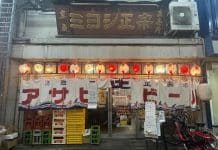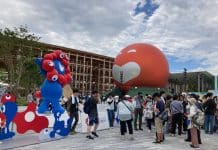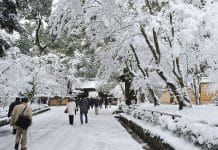The crime scene: the storage unit in the house of a mid-level oil merchant in Osaka in about 1720. Plenty of wooden oil barrels had been tumbled over in the criminal act, the floor is covered with oil. Twisted up in the center is the kimono-clad victim, a woman in her thirties. Detectives take notes on her visible injuries. Two fingers cut off, a great number of slashes, deep stab wounds.
The movie title springs up on screen and the story starts. Jumping back in time, the story unfolding details the developments leading up to the murder.

Onna Goroshi Abura no Jigoku is the Japanese title of the 1992 film, literally translating to Woman Murder in Oil Hell.
Onna Goroshi Abura no Jigoku is also the title of a bunraku puppet play penned by Chikamatsu Monzaemon (1653 – 1725). Though written as a puppet play, Chikamatsu’s play was also performed as live action kabuki play. Both versions were reportedly first performed in 1721. The play was most likely inspired by an actual Osaka murder case.
The movie on hand, directed by Hideo Gosha, is loosely based on Chikamatsu’s original play. Director Gosha uses the original setting, the world of more or less wealthy Osaka seed oil merchants in the early 1700s with their complicated but rigidly enforced social structures.
Gosha also employs the main characters of the original play but has them act out their passions in quite different ways.

Okichi (Kanako Higuchi), who we recognize as the murder victim, is the wife of a mid-level Osaka seed oil merchant, specializing in lamp oil. For reasons not fully explained, her family had taken in and raised Yohei, the son of a related but much more wealthy oil merchant family as an infant. Okichi was like a mother to Yohei but by now, Yohei (Shinichi Tsutsumi) has become a grown man.
Yohei doesn’t care much for work and rumors in the neighborhood abound that Yohei likes to go to the pleasure quarter, consorting with prostitutes.
The truth is however that Yohei has a secret relationship with Kogiku (Miwako Fujitani), the daughter of an ultra-rich oil merchant. Meeting in the pleasure quarter is their way to disguise the inappropriate relationship.
Okichi finds out and confronts Yohei. She’s not the only one finding out, though, and the whole affair leads to big troubles for all the various oil merchant families involved.

Yohei starts to plot shinchu (lover’s suicide) with Kogiku but she’s just in with Yohei for the fun of it, not for anything as serious as a relation leading to a lovers’ death.
After various twists and turns Kogiku’s family gets simply tired of it all. They marry her off in an incredibly elaborate wedding ceremony to someone even wealthier, an overwhelmingly rich dowry going with her. We never get to see her husband.

Yohei is still not quite over with Kogiku but soon learns that she uses her new position to sleep around with as many men as she wishes.
End of Act One. As in any theatrical play, there are several acts and that is the case here too.
Table of Contents
The Oil-Hell Murder (Japan, 1992) 女殺油地獄
Enter Act Two. Okichi, who had always been the voice of reason in Act One (Was she? Didn’t she spy just a bit too much on Yohei?) now turns into the predator. The horny milf, to use a more recent expression.
She declares her love to Yohei, her former adopted son who she breast-fed when he was young. She feels that by now, Yohei is a full-grown man and anyway, her husband can’t provide her with any real pleasure…
Yohei, on the other hand, has somewhat sobered-up after his affair with Kogiku and wants to lead a straight, hard-working life, growing the seeds for the oil out in the countryside.
Trying to get away from Okichi’s passion, Yohei decides to move to Edo. On his last night in Osaka, his boss sends him over to get a barrel of oil from Okichi’s house. There, one word leads to another … leading to the oil-hell murder whose aftermath we have seen in the opening scenes of the movie.

The Play
Chikamatsu Monzaemon (1653 – 1725) was considered the greatest playwright of his generation in Japan. He wrote both bunraku puppet plays as well as live action kabuki plays. In the later part of his career, he exclusively went for the puppet plays.
That may have had to do with the fact that bunraku puppet plays became very fashionable after about the year 1700 and were thus more profitable for the authors.
Another, and perhaps more important factor may have been that kabuki plays were often tailor-made to fit certain famous actors of the era. Those actors were superstars in their day, they led superstar lives and would only take on roles that would exactly fit the image they tried to project.
Bunraku puppets on the other hand could be assigned to do anything the author envisioned. They could be put through the wringer no matter what. Therefore, puppet plays offered a lot more freedom to the authors than live theater.
Nonetheless, many bunraku plays were also performed as kabuki plays.
This was the case with Chikamatsu’s Onna Goroshi Abura no Jigoku. According to old records, neither version proved popular at the time of their original performance in the 1720s. They were easily overshadowed by other Chikamatsu works; the subject matter may also have seemed a bit too close to home to some of the original audiences.
Onna Goroshi Abura no Jigoku was rediscovered as a bunraku / kabuki masterpiece in the late 19th / early 20th century and has remained wildly popular on stage in Japanese theaters ever since.

The Play and the Film
The original play offered up a lot of possibilities for a movie director in the early 1990s. It could have been turned into a bloody sex & murder tale featuring lots of nudity and violence, it could have been used as a tool for social critique on traditional feudal mores.
Director Hideo Gosha went a different route. Using excellent actors, he turned the puppet play into a character driven movie, focusing on the ever-changing minds of the three main characters Okichi, Yohei and Kogiku.
In the film as in the play, those characters act within the framework of their time, peaceful but rigid Edo era Japan. They all try to beat the system they live in.
In the original play, Yohei is an irredeemably bad character, patronizing prostitutes way beyond his financial means. That puts him deeply into debts with shady money lenders.
In the play, Kogiku is simply as prostitute… a high-level prostitute, though, able to charge for her services way beyond Yohei’s means.
Okichi on the other hand is simply the wife of a rich oil merchant, Yohei kills her for money. The play contains neither a story of Okichi nursing Yohei as an infant nor any later love story between Okichi and Yohei.
Director Hideo Gosha not only changes the characters of the main personnel, he went all out in terms of wardrobes. Everyone in the movie and especially Kanako Higuchi as Okichi are always perfectly styled and dressed. In a way that would appeal to modern audiences.
In Edo times, married women had their teeth blackened to show their marital status. In the movie, Kogiku’s mother appears onscreen with her teeth blackened … but Okichi (also a married woman) is free to flash her white teeth. Director Gosha clearly opted to cater to the tastes of his modern audience rather than recreating historical fashion facts.
Add to that the clean-swept exteriors. There are plenty of characters stealthily moving through the streets at night. It looks rather like them moving through a studio set than any old Osaka street of yore.
While the acting and the character presentations are no doubt top-notch, the artificial settings the characters inhabit are more like those of a TV drama. Which shouldn’t come as a surprise, considering that Fuji Television poured some serious money into the film.
The main production company was Shochiku Studio however and Shochiku handled the theatrical distribution in Japan.
The film was submitted as the official Japanese contender for the Academy Awards 1993 but was rejected by the selection committee.
The Director: Hideo Gosha
Hideo Gosha (1929 – 1992) served in the Imperial Navy during World War II. Soon after the war, Gosha started to work for TV, first as reporter, then as producer and director. One TV show he shot, samurai-themed The Three Outlaws, impressed the studio heads at Shochiku so much that they offered him the chance to re-create the show as a period drama film of the same title. The film, released in 1964, became a success and started Gosha’s career as movie director.
Gosha became famous as a director specializing in samurai sword fight movies. In the 1970s, he also directed a couple of well received yakuza crime movies. By the 1980s, he switched to harshly realistic period dramas focusing on prostitutes, movies that were both praised and condemned for their drastic depictions of violence and sex.
In contrast, his The Oil-Hell Murder features very little violence, almost no nudity and sex is rather alluded to than seen on screen.
The Oil-Hell Murder was Hideo Gosha’s last film. He died in the same year of its domestic release, in 1992.

Actress Kanako Higuchi
Kanako Higuchi (born in 1958) plays the role of Okichi in The Oil-Hell Murder. She started out with Edo Porn (aka Hokusai Manga), directed by legendary movie master Kaneto Shindo in 1981. The film depicted the domestic live of woodprint master Hokusai in the early 1800s, Higuchi acted alongside Yuko Tanaka.
Higuchi may be most famous for her leading role in the 1989 samurai movie Zatoichi by Shintaro Katsu.
Higuchi is still active today both in the movies and on TV.

Actor Shinichi Tsutsumi
Shinichi Tsutsumi (born in 1964) plays the character Yohei in The Oil-Hell Murder.
Tsutsumi may be best known for his lead role in Monday (2000), a wild satire directed by Sabu (Hiroyuki Tanaka) and starring Tsutsumi as a businessman waking up in a hotel room with a heavy hangover and no memory left of the previous days. The more clues the businessman finds on what had been going on, the stranger the movie gets.
Tsutsumi is still active on the big and small screens today.

Actress Miwako Fujitani
Miwako Fujitani (born in 1963), playing Kogiku in The Oil-Hell Murder, is by now better known as Miwako Okamura after her marriage to theater director and actor Shunichi Okamura.
Fujitani had only a brief career in the movies but became famous as a singer in the 1990s.

Actor Ittoku Kishibe
Ittoku Kishibe (born in 1947), that’s the actor with the always smooth and stoic face – but when he does get angry, he is angry from deep within. Kishibe plays the oil merchant husband of Okichi in the movie.
Kishibe is one of Japan’s most prolific actors, the Internet Movie Data base lists him as acting in 214 films so far.
To foreign audiences, Kishibe may be best known for his roles in various Takeshi Kitano movies (Violent Cop, 1989; Zatoichi, 2003), for playing the anatomy professor in Shinya Tsukamoto’s Vital (2003) and his crazy role as a father being hypnotized into believing he is a bird in the 2004 cult favorite Survive Style 5+.

Osaka Locations
The story the film tells takes clearly place in Osaka in about the year 1720. Dialogues often mention the fact. There are also various mentions of local landmarks such as Tenjin Bridge. Characters say that they will go to Juso or to the Ikeda District.
All those locations place the story into the northern part of Osaka, to today’s Kita and Yodogawa Wards.

Whenever the characters need to travel somewhere, they do so by boat. Osaka, the City of Rivers.
Actual historic landmarks are however never in sight. All the buildings depicted are obviously movie studio creations.





















